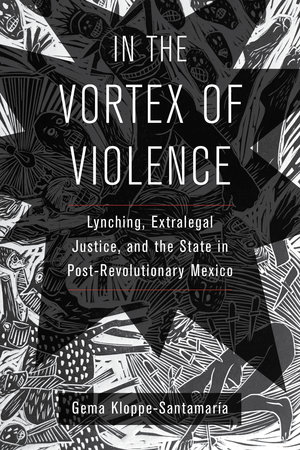by Gema Kloppe-Santamaría, author of In the Vortex of Violence: Lynching, Extralegal Justice, and the State in Post-Revolutionary Mexico
In November of 2004, three federal police officers were lynched in the neighborhood of San Juan Ixtayopan in Tláhuac, Mexico City. The policemen, dressed in plain clothes, were seen outside an elementary school taking pictures. Suspicious of their presence, a group of neighbors began circulating a rumor claiming that the three men were part of a criminal organization responsible for kidnapping children. After a group of neighbors rang the local church’s bells, around 300 people gathered outside the school and surrounded the men. After beating them and dragging them through the streets, they burned two of them alive. The national television network Televisa live-broadcasted the incident, amplifying the number of witnesses to this spectacle of violence from a few hundred to thousands.
I learned about this incident while I was a college student in Mexico City. Like so many other city residents, I was shocked by the level of brutality of this lynching and the explicit anger and sense of distrust towards state authorities. More than a decade later, I would return to the lynching in Tláhuac, while studying the history of the difficult but critical topic of lynching in Mexico.
Despite its level of cruelty, the lynching in Tláhuac was not exceptional. It was in fact similar to hundreds of other cases during the twentieth century across different states of central and southern Mexico. Many of these cases shared both the script underlying these collective attacks – the tolling of the church bells, the circulation of rumors, the torturing and burning of bodies in a visible public space – as well as the political and sociological drivers informing their occurrence – distrust in state authorities, heightened perceptions of crime, as well as perpetrators’ understanding of lynching as a legitimate means to punish social transgressions. Furthermore, as in the hundreds of cases I have examined, state authorities were not absent. Rather, their presence was either unwelcomed or perceived as illegitimate by citizens who consider state actors – saliently police officers and judges – as either negligent or complicit in the commission of crimes.
The story of how I came to write my book, In the Vortex of Violence, is also the story of how I became a historian and historical sociologist. As I began reading and researching about lynching in Mexico and other Latin American countries – including Brazil, Guatemala, Bolivia, Ecuador, and Argentina – I realized there was no single scholarly work that systematically analyzed the history of this practice prior to the 1980s. In contrast to the trajectory of lynching in the United States, which several historians have examined at length, Latin America’s history of lynching remained untold. Due to their focus on contemporary cases, most scholars have interpreted lynching as a recent phenomenon. They portray lynching as a product of unfinished processes of democratization that, paired with neoliberalism, has led to a surge in vigilante forms of justice in the face of state authorities considered absent, weak, or in crisis. While some elements of this narrative are valid and useful to explain present-day cases, there are several aspects of the phenomenon that this narrative overlooks.
To begin with, lynchings are not new to Latin America. In the case of Mexico, the history of lynching begins in colonial times, even though the term did not become widespread until the second half of the nineteenth century. Signaling the importance that lynchings in the United States had in Mexico’s own understanding of this practice, the word “lynchamiento” retained its English orthography until the late 1930s when it began to be spelled as “linchamiento.”
The history of lynching helps unravel the long-term political and cultural drivers of this practice, the reverberations of which continue to be felt today.
Gema Kloppe-Santamaría
Acknowledging that lynching is not new to Mexico is not only a matter of historical accuracy. The history of lynching helps unravel the long-term political and cultural drivers of this practice, the reverberations of which continue to be felt today. In particular, the history of lynching during the formative decades of Mexico’s post-revolutionary period (1930-1960) shows that rather than being a sign of state absence or state failure, lynchings expressed how state authority was forged in the country at the local level through the use of abusive and coercive practices that were both resisted and emulated by members of given communities.
Although crime and perceptions of crime have been key in the organization of these acts, this form of violence has also been driven by religious beliefs, witchcraft accusations, and political conflicts. Impunity was and continues to be a central factor in legitimating this practice in the eyes of perpetrators. However, lynchings were not only the result of the state’s incapacity to deliver justice. Lynchings also reflected citizens’ support for swift, extralegal, and potentially lethal forms of punishment against social transgressors and suspected criminals.
It is in this later aspect that the “vortex of violence” my book recounts becomes manifest: it was not only the state but also citizens themselves that participated in the production of violence. With the aim of attaining a fragile and ephemeral sense of security and justice, citizens in Mexico and other Latin American countries, today as in the past, decide to take matters into their own hands. In the process, they transgress the law, exclude and harm people perceived as “others,” and ultimately hurt the possibility of building more peaceful and inclusive societies.

